The City of London is home to many curious little green spaces, gardens that today are often teeming with office workers enjoying their lunch on a sunny day. The little garden pictured below is just one of them, a small space nestled between office blocks and the busy thoroughfare of London Wall. In the introduction to his 1901 book The Churches and Chapels of Old London, J G White notes that “the sites of old churches are very plainly indicated in most instances by little green spots, formerly church-yards, now changed into pleasant gardens and resting places.” The subject of today’s post is the “green spot” on the site of the church of St Olave, Silver Street.

Many of the City’s churches were closed and demolished as the area’s population began to decrease in the 19th Century, and more were destroyed in the Blitz and never rebuilt. St Olave’s was situated in a part of the Square Mile that was particularly heavily hit by aerial bombardment during the Second World War – it lies just south of London Wall and the Barbican complex, an area devastated by the Luftwaffe. Silver Street, where William Shakespeare once lived, is no longer on London’s maps, utterly wiped out by the devastation of the Blitz.
However, St Olave’s was in fact one of the churches that was not rebuilt after that earlier catastrophe to hit London, the Great Fire of 1666. Before the Fire, St Olave’s had been a small, unremarkable church that had for most of its history been built out of wood. Following the Rebuilding of London Act of 1670, the parish was merged with the nearby St Michael Wood Street (itself demolished in the 19th Century and merged with St Alban Wood Street) and a skull and crossbones stone was later installed to mark the site of the former church. This might have been the end of the story, but a little investigation revealed the role St Olave’s played in the development of the study of anatomy.

Long before the infamous era of the bodysnatchers, the Barber-Surgeons’ Company was founded in 1540. The Company was formed as a result of an Act of Parliament, which amalgamated the Surgeons’ Guild and the Company of Barbers. As barbers worked with sharp tools it was common for them to also carry out minor surgical procedures, but in the new Barber-Surgeons’ Company the two professions were ordered to operate separately, with practitioners of one profession forbidden from carrying out the activities of the other. This caused a great deal of strife between the barbers and the surgeons, and the Company eventually split in 1745. However, the creation of the Company also set in law the Company’s right to dissect four bodies of executed criminals each year.
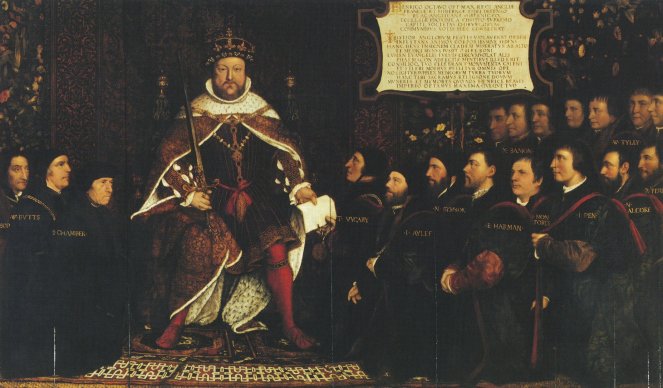
It later became common for the bodies of executed criminals to be dissected for anatomical research, but the legislation passed in 1540 was the first to legalise this practice in England. The cadavers that the Company was licensced to dissect were dissected in public, with all surgeons ordered to attend. These dissections became so popular that by 1568 it was necessary to provide raised seating in the Barber-Surgeons’ Hall to give the audience a better view – this is an early example of how the term “operating theatre” came into being. Eventually a purpose built anatomical theatre was designed by Inigo Jones – this building was destroyed in the Great Fire and later rebuilt to a design by Christopher Wren.
But where does St Olave’s fit into this picture? Unlike later examples where skeletons and viscera of dissected criminals were retained for educational purposes, the cadavers dissected by the Barber-Surgeons’ Company were interred in the burial ground of St Olave’s. The Company’s Hall was (and remains) close to St Olave’s, and indeed within the parish there resided an early pioneer of anatomy and surgery, John Banister (1533-1610).
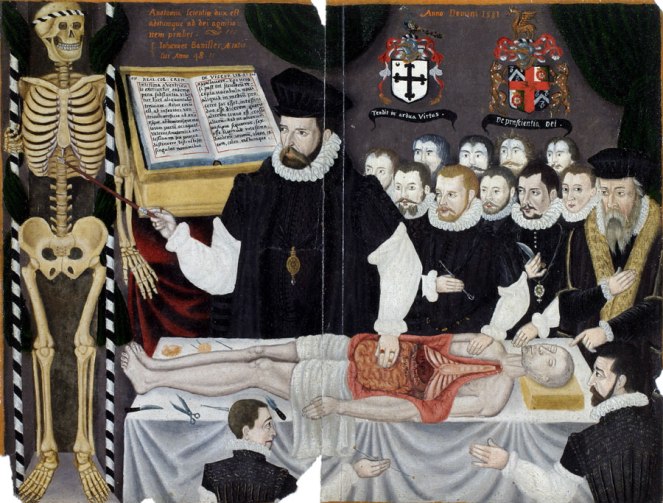
John Banister was an illustrious figure from the early years of the Barber-Surgeons’ Company. After beginning his career as a surgeon to the forces of the Earl of Warwick, he was admitted into the Barber-Surgeons’ Company in 1572 and later became a Lecturer in Anatomy there. Banister published many works on anatomy over the course of his career, with his best known being The Historie of Man, from the most approved Authorities in this Present Age, which was published in 1578. Banister lived on Silver Street and was buried in the churchyard of St Olave’s when he died in 1610. His works were considered authoritative enough that over twenty years after his death, his works were collected and published as The Workes of that Famous Chyrurgian, Mr. John Banester in 1633.
Although the church was not rebuilt after the Great Fire, the churchyard remained and was presumably still in use until the Burials Act of 1851 closed all of London’s churchyards due to overcrowding. The entry for Henry Harben’s A Dictionary of London, published in 1918, simply states of St Olave’s churchyard: “it still occupies this site.” A small, undated photograph gives us a glimpse of how the burial ground looked before the Second World War – it has to be assumed that the tombs pictured were destroyed by bombing or removed when the devastatated area was cleared of rubble as almost nothing remains today of any tombs or headstones.
The churchyard was reduced in size in 1865, when a plaque was installed that reads “St Olave’s Silver Street / This graveyard was thrown back and the road widened eight feet, by the commissioners of sewers at the request of the vestry Anno Domini 1865 / H J Cummins, Rector / F J Harris, C E Wilson, Churchwardens“.
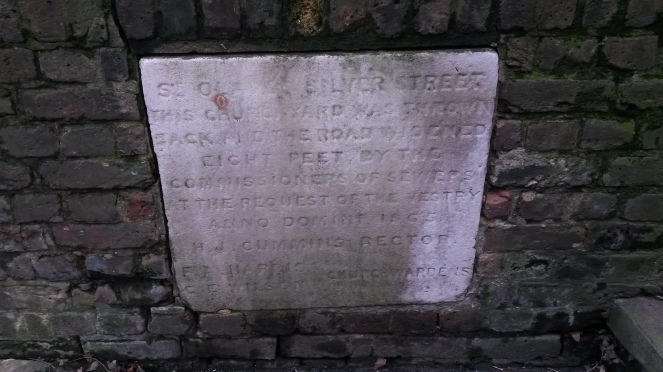
It is not certain when the distinctive skull and crossbones plaque dates from – it may be of a similar age to the plaque pictured above, or it may have been installed much earlier – one unattributed source I came across dates it to 1690. The inscription on this plaque reads “THIS WAS THE PARISH CHURCH / OF ST OLAVE SILVER STREET / DESTROYED IN THE DREADFULL / FIRE IN THE YEAR 1666”.

The only other feature of any note is a strange, font-like structure that looks as though it was once perhaps a column – there is no written information to be found about this item so we can only guess at its origins. It could possibly be the remains of a larger, destroyed structure from the old churchyard or a building nearby.
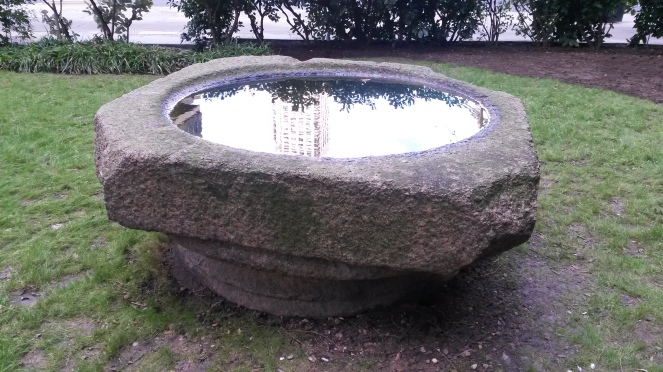
It’s always odd to think about how much history lies under seemingly dull, innocuous sites like St Olave’s. It was never a large or illustrious parish while it existed, but the small role that St Olave’s played in the development of the study of anatomy opens a door into a fascinating part of the history of medicine. Perhaps, though, it’s not the best idea to think too much about those dissected cadavers whilst sitting on a bench in the garden eating lunch…
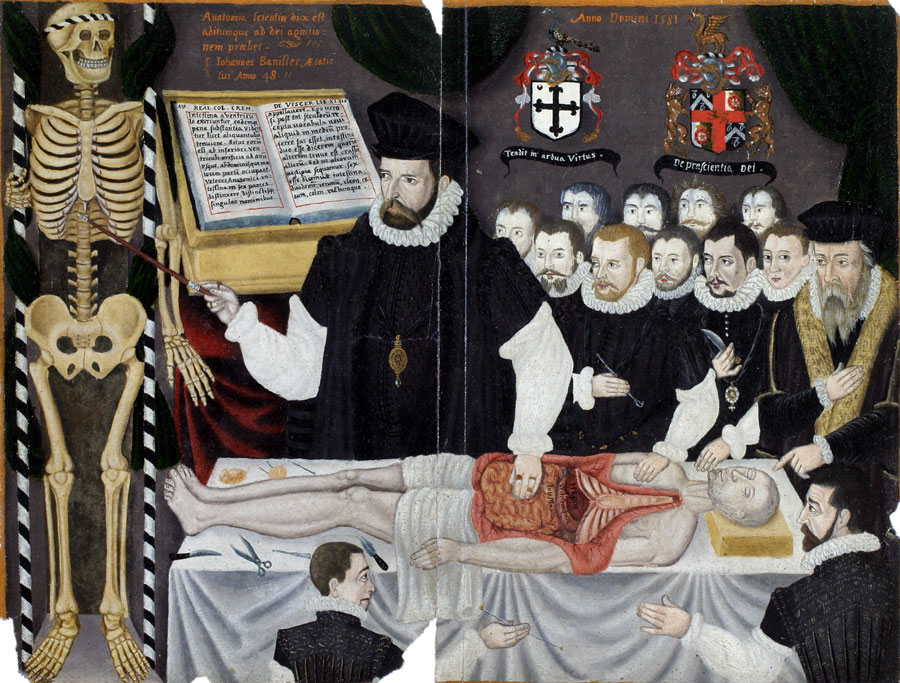


Excellent post. A very interesting bit of London history I’d never come across before.
LikeLike
Thank you! It’s a site that’s easy to miss – I’d walked past it for years before realising it was an old burial ground.
LikeLike
Lovely piece. I walk past about once a week and had often wondered about the skull and crossbones. I had no idea about the anatomical links. Thanks!
LikeLike
Thanks Matt! Sometimes I wonder if there’s a part of the City that *doesn’t* have some interesting historical link.
LikeLike
What a fascinating post.
LikeLike
Thank you!
LikeLike
I wonder about the name: St. Olave – is he the king-saint Olav of Norway who died in 1030?
LikeLike
Yes, that’s the one! There is another church in the City dedicated to the same St Olav, at Hart St (where Samuel Pepys is buried).
LikeLike
I’m delighted by the origin of the term operating theatre! Thanks.
LikeLike
Yes, for a long time I had no idea that the term had very literal origins!
LikeLike
Thank you, Caroline. My immigrant ancestor Thomas Fox was baptized at St. Olave’s, Silver Street in 1619 and by 1638 he was settled in Concord, Massachusetts Bay Colony. I’ve visited the site twice, most recently in June 2015, and your piece pulls together the known information beautifully. BTW, a Stanford ancient-archaeologist says the “font-like structure” is the base of a column.
LikeLike
He observed that the base is “upside down.”
LikeLike
Thank you! Always great to hear from people with family connections to the places featured on this blog. I think you are right about the font-like structure, it does look as though it comes from a column.
LikeLike
Hi Karen Fox, then I have to be your Fox cousin, thru my mom. Direct from Thomas Ffoxe, Jr. of Concord. Did you know that the kitchen and dining room from the house he built in 1638 was later attached to the home of writer Louisa May Alcott? And it has all kinds of nooks and crannies celebrated under the name of The Orchard House Museum? And Hawthorne from next door, Thoreau and Ralph Waldo Emerson used to hang out there with her dad, Bronson, who invented recess. Another house the Foxes built on the grounds of Harvard U. was the birthplace of Oliver Wendal Holmes, Jr. Hope to hear from you.
LikeLike
Hi, Myreen– I’m descended from Thomas Fox’s youngest son, Isaac. Which of Thomas’s children are you descended from?
In 2006 on a visit to Concord I went to Orchard House and looked closesly at the kitchen which was supposedly from a house built by/for Thomas Fox and asked the official guides about the story. They put me in contact with the official historian of the house and we met there. She explained that the Fox connection was *not* accurate and that the addition you refer to was built considerably after.
I don’t know where the story began but I trust the expert who knows all about the constuction history of the house.
When I visited in 2006 there were five Fox houses extant in Concord, built by Thomas’s son Eliphalet and his sons, and all had plaques from the 1976 Bicetennnial. Fox Road in Concord runs along one of the Fox properties, so lots of traces of our ancestors remain.
I visit the remaining churchyard of St. Olave’s whenever I’m in London, most recently in September 2019. It is right at the original Roman, later City, Wall.
Karen Fox
kfox@scu.edu
LikeLike
Thanks for this terrific write-up. As some of you probably know, this site also has a Shakespeare connection. For a few years, Shakespeare rented a home from Christopher Mountjoy, a French hat-maker, who lived just across the street from this site. They would have worshipped at St. Olave’s, as would several of the actors from Shakespeare’s company, who also lived in the neighbourhood.
LikeLike
Good stuff, very interesting! Thank you so much, I’m really enjoying reading your posts.
LikeLike
Thank you!
LikeLike
Most enlightening. I had been reading through the parish burials register (Ancestry) for 1693-5 looking for ancestors. The parish clerk then was more informative than most at the time…quite a number said “exeruted person”, some adding “from Barber Surgeons Hall”…now I know why!
LikeLike